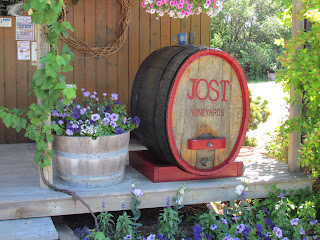FRUITS OF NOVA SCOTIA: JOST WINERY
Monday morning found us heading down the road towards a town
called Tatamagouche, then beyond to Malagash and the Jost Winery.
We pulled into an emerald green haven, row upon row of
grapevines in the fields surrounding the gift shop and winery buildings. We’d
let them know we’d be visiting on this trip, so the owner—Hans Christian Jost,
pronounced ‘Yohst’—greeted us himself
and took us on a tour of the facilities.
Hans Christian is a tanned, smiling, honorary Bluenoser,
just hitting his fiftieth birthday this week. He set the whole group at ease
with his friendly, down-to-earth style. My brother remarked at how he made wine
seem approachable, not pretentious—this metaphorically describes the Jost
wines, as well.
The Jost family came to Nova Scotia from Germany, where they’d
been winemakers since the 1700’s. They’d planned (a little ironically now) to
get away from the wine industry back home, when they made the move to Canada in
the 1970’s. Eventually, however, a few vines they’d planted to supply the home
became the main industry of the farm, and the Jost winery was officially opened
in the 1980’s.
Hans Christian has a background in Agriculture Economics,
and it shows in his approach: the vineyard makes wine based on German ideals,
and Jost in particular takes pride in a ‘waste not, want not’ philosophy: they’re
always looking for innovative ways to make a cleaner, fresher finished product.
It’s a fascinating combination of modern technology and simple old-school techniques:
using natural clay to pull the protein out of the wine, for example, but then using
modern research to find new water conservation methods.
The vineyard in Malagash supports sixty acres of gorgeous
vines, though they have more in other parts of Nova Scotia. All their grape
harvesting is done over 22 days in the fall—that means all the raw material for
their year’s production is gathered in less than a month.
 |
| Parts of the shop are made from reclaimed wine keg wood. |
Hans Christian did a tasting with us, sitting under the
vine-laden arbour beside the beautiful green fields. The seven of us sat and
sampled a selection of wines, learning new tips on sniffing the bouquet and proper
wine etiquette. Jost manages to produce wines with bright, crisp flavours; Hans
Christian explained that a wine doesn’t have to be big and bold to be
beautiful. By the end of the tasting, we all agreed wholeheartedly.
Jost wines are not currently available very often outside of
Nova Scotia; according to Hans Christian, the province drinks most of what they
can produce. This means, of course, that my family stocked up for the vacation,
with plans to revisit the vineyard before we leave next weekend.
Here are the wines we tried, with tasting notes by Brian—who,
by the way, was in Sommelier heaven.
 |
| Hans Christian teaches an intrigued audience. |
BEAR RIVER PINOT GRIS
2010 (WHITE)
This wine blew away
everyone in our party; a white that doesn’t burn your chest the whole way down is, apparently, possible! By far, Jordan’s
favourite wine of the trip; even Jordan’s dad drank this down.
Brian: “Fresh!
Definitely tons of green apple and peach. Medium acidity, light body, short
length—this wine quickly delights, then disappears. A bright bouquet; this wine
showcases the Jost filtering process because of its freshness and smoothness.
This is the perfect summer party or housewarming gift.” (Is that a hint,
Brian?)
TIDAL BAY 2011
(WHITE)
A special signature
Nova Scotia wine.
Brian: “It’s made
in the same fashion as wines from Chianti. It has a smooth, medium flavour with
slight spiciness to it on the finish. Holds up well with seafood—as any Nova
Scotian wine should. When you visit the province, grab a bottle of this to go
with your fresh lobster.”
EAGLE TREE MUSCAT
2011 (WHITE)
A dry wine with a
fruity bouquet; multiple personalities in all the right ways.
Brian: “This
grape variety was developed in Ontario, but is grown primarily in Nova Scotia.
This is the white wine for red wine drinkers. The bouquet surprised everyone,
with strong notes of lychee, grapefruit skins, and the entire citrus family.
The wine was full-bodied, but finished quickly, leaving the palette cleansed—another
characteristic of Jost’s crisp wine style. This is the perfect after-dinner
wine; it will pair very nicely with vanilla icecream and angel food cake.”
FOUR SKINS (RED)
 |
| Hans Christian Jost, Jordan, Brian. |
A blend of four
grapes, this red wine is popular as a crowd-pleaser.
Brian: “The aroma
has a mushroomy, almost dill-scented bouquet. It’s got a short length, medium
body, and is very simple. The Nova Scotian soil has imbued this with a
saltiness. Good pairing for well-done steak.”
JOST PORT
The term ‘port’ will soon be verboten to any vineyard not
actually in Portugal, so you may find this fantastic, beginner-friendly concoction
under a different name. But a bouquet this fine, by any other name, will be as
sweet.
Brian: “The ultimate
beginner port. The low alcohol content means that it doesn’t get too hot in
your throat. The aroma has a plum richness, as any port should; but as soon as
it hits the palette, it has a sweet, candy-like flavour. This port will be
appreciated by the advanced port lovers, but is definitely approachable for the
beginners venturing out into the world of port.”
Visit the Jost Winery on your own visit to Nova Scotia, or
look them up online at http://www.jostwine.com








No comments:
Post a Comment